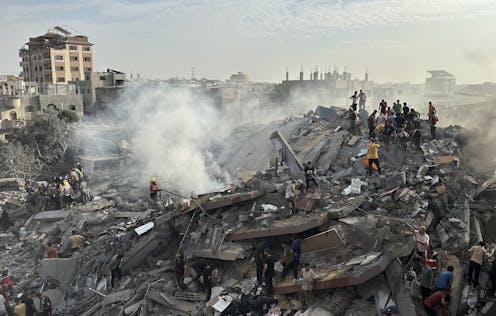
Palestinians look for survivors after a Israeli strike in Gaza on Oct. 31, 2023. AP Photo/Doaa AlBaz
Over a decade ago, a United Nations report described the Gaza Strip as virtually unlivable, adding that it would require “Herculean efforts” to change that.
Today, after six months of bombardment, mass displacement and siege by Israel, the task of rebuilding Gaza seems practically unimaginable.
I’m a scholar and a systems engineer who, as research director of the Center for Health and Humanitarian Systems at Georgia Tech, looks at the intersection of public health and education, with a focus on optimizing systems for effective and equitable access to essential services.
I know that in the best of times, designing complex systems that involve people, communities, technologies and limited resources – often with conflicting priorities and impacting multiple segments of society – is an extremely complex challenge. Doing so in the midst of a geopolitical conflict makes the problem seem infeasible.
But what we are dealing with now in Gaza is on a different scale altogether. The enclave is facing cascading crises – a condition in which multiple interrelated crises occur sequentially or simultaneously, each triggering or exacerbating the next. And as hard as it is to look beyond the daily horrors of warfare in Gaza, there will be a time when the world starts to turn to recovery and reconstruction. The concern is that the cascading crises will make this process that much harder and moreover amplify the human costs of this conflict for years to come.
Beyond the death toll
As the 2012 U.N. report questioning Gaza’s “livability” alludes to, the occupied enclave has long faced severe problems relating to providing for the people living in what is one of the most densely populated areas in the world. My mother, who lives in the West Bank, often visited Gaza in her capacity as a member of the Palestinian National Council and the General Secretariat of the General Union of Palestinian Women. She would share tales of its rich culture but also of noticeable issues like the persistent sewage smell and unemployment exceeding 45%.
Of course, after months of Israeli bombardment following the Oct. 7, 2023, attack by Hamas, the immediate concern is for people’s lives. Already, the conflict has killed more than 33,000 people in Gaza, according to health authorities in Gaza.
But devastation caused by armed conflicts extends beyond immediate casualties. Causal pathways – that is, chains of events through which the long-term consequences will be felt – mean the current conflict will almost certainly lead to lasting societal and health crises. And these, research has shown, can overshadow the destruction that results from an active conflict both in scope and in severity.
Analysis of 13 recent armed conflicts by the Geneva Declaration Secretariat, a U.N.-backed initiative, found that indirect deaths exceeded direct deaths in 12 of them.
The report places a conservative estimate that for every person directly killed by war, four more are killed by its indirect consequences – things such as waterborne diseases due to the lack of safe, clean water and destruction of water sanitation facilities, or deaths due to birth complications because of health services being disrupted.
Given the scale and scope of destruction of six months of bombing, the consequential impact of war in Gaza may be even worse. And whereas there is usually a lag before these effects are felt, in Gaza they are already occurring. Economic collapse, infrastructure destruction, environmental damage and displacement have created a multidimensional crisis.
Compromised systems
To understand the challenge of overcoming cascading crises in Gaza, it is worth taking a snapshot at the impact of the monthslong conflict.
The war has devastated the enclave’s economy. The U.N estimated in mid-February that almost half of all cropland had been damaged and that some 70% of Gaza’s fishing fleet had reportedly been destroyed.
In the first few months of bombing, nearly 70% of Gaza’s 439,000 homes and about half of all buildings – including commercial outlets – were damaged or destroyed.
Meanwhile, the destruction of Gaza’s health infrastructure has led to about three-quarters of hospitals and two-thirds of primary health care clinics shutting down, leaving only 10 out of 36 hospitals barely functioning – amputations are carried out without anesthesia, and miscarriages have increased by 300%.
A wounded Palestinian boy is treated on the floor at the Al Aqsa hospital in Gaza.
AP Photo/Ismael Abu Dayyah
This health crisis has been worsened by a lack of clean water and essential medical supplies. It has contributed to soaring rates of infectious diseases, acute respiratory infections, severe dehydration and diarrhea.
Hospitals and clinics struggle to operate without electricity, and many health care workers have been injured or killed, which drastically affects the capacity of the health care system. And many schools and universities have been destroyed, making education inaccessible. When the war does end, Palestinians in Gaza will emerge from conflict with their education, health, housing and economic systems all deeply compromised.
The cost of rebuilding
These factors are all interconnected. In other words, they worsen one another and create a cascading effect of negative outcomes for Palestinians in Gaza. Take, for example, the issue of mass displacement, with 1.7 million people forced from homes that have been largely destroyed: This impacts people’s ability to make a living, leading to increased poverty and a higher risk of malnutrition.
The conflict’s aftermath necessitates rebuilding multiple facets of society, including social structures, health, infrastructure and education – all of which have been disrupted in profound ways.
Take education as another example: The disruption of schooling for children not only affects individual learning and development but also has long-term implications for the overall well-being of the community. The trauma of war means many children will face severe challenges even when the bombs stop. This education loss will impair employment opportunities, which in turn has an effect on the overall economy.
Addressing this will require an integrated approach that not only focuses on the physical rebuilding of schools but also considers the quality of education and psychological and social support for children. The U.N. projects that 1 million children – almost every single child in Gaza – will need mental health and psychosocial support. Meanwhile, the reconstruction of Gaza’s public health systems will require solutions that are not just about addressing immediate medical needs, but that also consider the broader infrastructure – including mental health services and vaccination programs, as well as the provision of essential medications.
Rebuilding cities facing cascading crises the nature of which Gaza is confronted with is a daunting prospect. And while the task may seem insurmountable at the present, with cooperation, coordination and courage it is not unachievable.
But it is a challenge that becomes that much more difficult with each day that the war in Gaza goes on.
Dima Nazzal does not work for, consult, own shares in or receive funding from any company or organization that would benefit from this article, and has disclosed no relevant affiliations beyond their academic appointment.
Advertisement

Advertisement
Contact Us
If you would like to place dofollow backlinks in our website or paid content reach out to info@qhubonews.com











